
Lawrence Lek, NOX, 2023. Installation view, LAS Art Foundation, Kranzler Eck, Berlin. © Lawrence Lek. Commissioned by LAS Art Foundation. Photo: Andrea Rossetti.
LAS Art Foundation, Kranzler Eck, Berlin
27 October 2023 – 14 January 2024
by DUNCAN BALLANTYNE-WAY
Discussions about artificial intelligence (AI) are nearly always accompanied by warnings about its unchecked development. Without regulation, so the warnings go, reckless corporations in competition with each other will endanger society and put human lives are risk. That depends, of course, on how it is programmed and what ethical structures are woven into its operating system. In Lawrence Lek’s latest work, NOX, the AI system comes across as a nurturing, almost empathetic, force, capable of focusing (after payment) on the wellbeing of its service entities and initiating an imaginative form of healing. This distinctly utopian conceit raises all manner of questions about how the technology is developed and, more pointedly, the relationship between humans and the machines they construct.
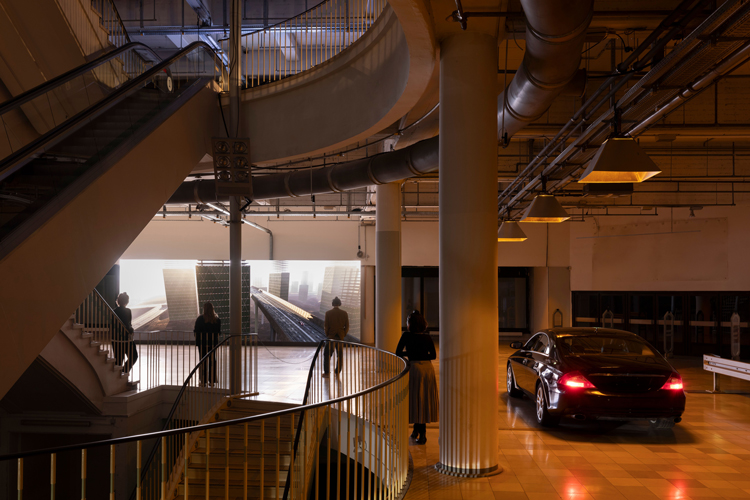
Lawrence Lek, NOX, 2023. Installation view, LAS Art Foundation, Kranzler Eck, Berlin. © Lawrence Lek. Commissioned by LAS Art Foundation. Photo: Andrea Rossetti.
Unfolding over three floors of the Kranzler Eck on Kurfürstendamm, the temporary home of the Berlin-based organisation LAS Art Foundation, NOX is a sprawling multitiered project, featuring interactive game stations, locative sound, video and installations. Focusing on the experience of Enigma-76, a sentient, self-driving car, as it undergoes a sort of mid-life crisis, the installation delivers a richly complex story. It ends with the human customer (sponsor) initiating a treatment procedure, to ensure the autonomous car receives spiritual rehabilitation.
So it is a bit of a letdown when you first enter this futuristic world and see black saloon cars near the entrance. Surely sentient AIs would zoom around in something more visionary than your average BMW driver? Later, you see what the artist is doing, distorting the boundaries between the real and virtual worlds by collaging material interior installations (however humdrum) with the more forward-thinking and ambitious games and videos. NOX is just the latest instalment in the German-born artist’s sinofuturist cosmos of highly cinematic and material artworks and by now it is a well-oiled process.
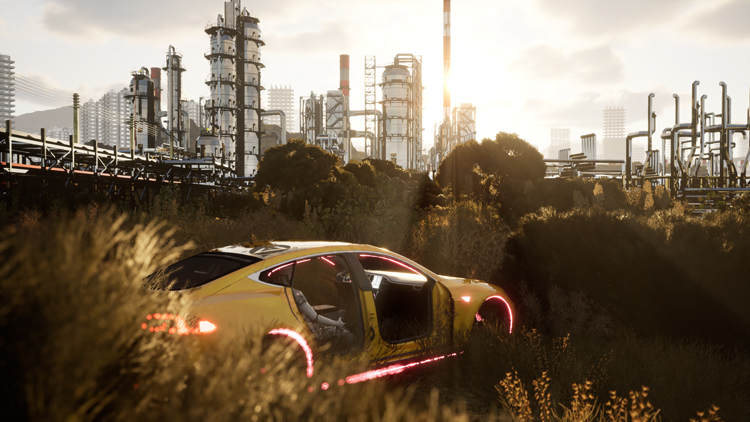
Lawrence Lek, NOX, 2023. Commissioned by LAS Art Foundation. © Lawrence Lek.
On the ground floor, a giant screen wall reveals an arid, post-industrial near-future, that gradually introduces viewers to the autonomous car’s unsettled state of mind, through a measured, rather effete-sounding interior monologue. The car feels “earth bound and insignificant, timeless and unbound”. Diagnosing this existential crisis, the overseeing Farsight Corporation, a fictionalised AI conglomerate, prescribes a treatment at NOX (short for non-human excellence). There, the car can receive “equine therapy” – a form of healing that involves gallivanting through a valley with a muscular brown horse.
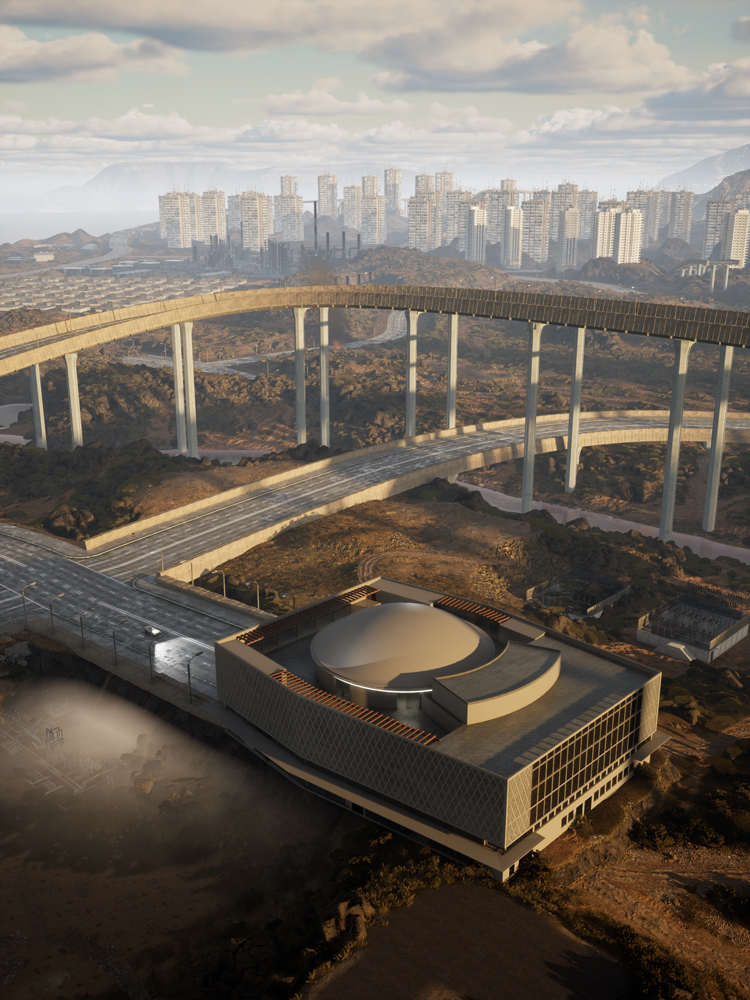
Lawrence Lek, NOX, 2023. Commissioned by LAS Art Foundation. © Lawrence Lek.
This spiritual remedy is the climax of the work and has been excellently put together. The nomadic wanderer is a familiar thread running through Lek’s work and, after the isolated car has stumbled on its animal companion, the sequence builds in an uplifting cinematic crescendo, with the sunlight breaking over the horizon. Presented as a chance encounter (unlike Enigma-76, we are privy to the fact that this has been engineered), it is as if the viewer is controlling his own game simulation, becoming the custodian and the deceiver. It adds to the unsettling sense of detachment that permeates the work. “Riding horses promotes non-human excellence,” Farsight tells us. The autonomous car revels in a false sense of independence that has been entirely sanctioned by its off-screen human owner.
It seems symbolically apt that a horse could lead the sentient AI out of its existential malaise; for so long the human-centric idea that only humans are capable of genuine feeling and empathy can be applied to animals as much as it can to super intelligence. At one point, Enigma-76 comes across the “cars he grew up with. Bright minds and cheap bodies, dreaming of getting permits and making it out of the town.” Human inequality is just as easily translated on to the sentient beings in a technocapitalist near-future.
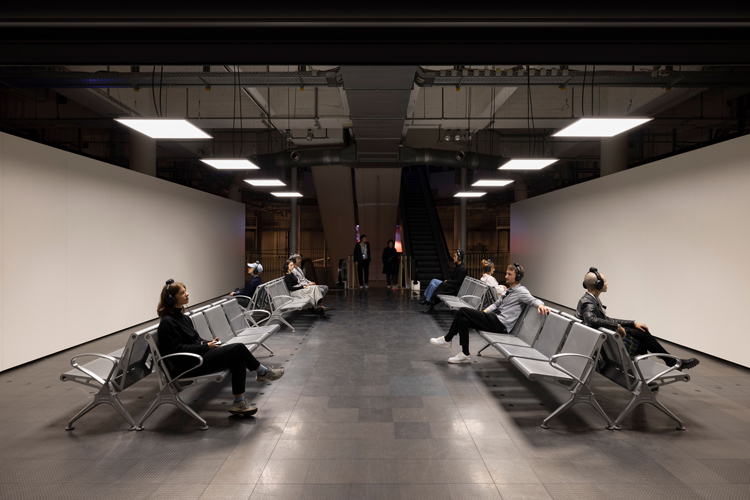
Lawrence Lek, NOX, 2023. Installation view, LAS Art Foundation, Kranzler Eck, Berlin. © Lawrence Lek. Commissioned by LAS Art Foundation. Photo: Andrea Rossetti.
Lek has incorporated the architectural form of the Kranzler Eck, a former department store with a distinctive tessellated facade, into the virtual NOX treatment facility. Inside, Farsight-branded surveillance cameras swivel into position, but rather than coming across like a shadowy, all-powerful entity, hell-bent on controlling the world, Farsight (the corporation recurs throughout Lek’s most recent work) gleams with all-seeing ambivalence. The material interior of the building has been transformed into a treatment plant for cars. This open, largely empty, non-human environment is kept moodily dark, with chairs – in the form of car seats – kept to a bare minimum. Rather than furniture in front of the screen walls, there are thin-carpeted car platforms (it is as uncomfortable as it sounds).
One of the most striking installations is the splayed-out car, with its exterior segments disassembled and fixed into an expanded position. Enigma-76, preoccupied with the precariousness of his existence, knows that physical imperfections can be repaired but: “If we’re deemed mentally damaged, then that’s another story.” That overlapping of the material and virtual, the sensory immersion brought about by many competing elements, makes for multilayered and interwoven narratives that jump effortlessly between a hard-edged disconnect and, in the narrative videos especially, a more ethereal, fragile quality.
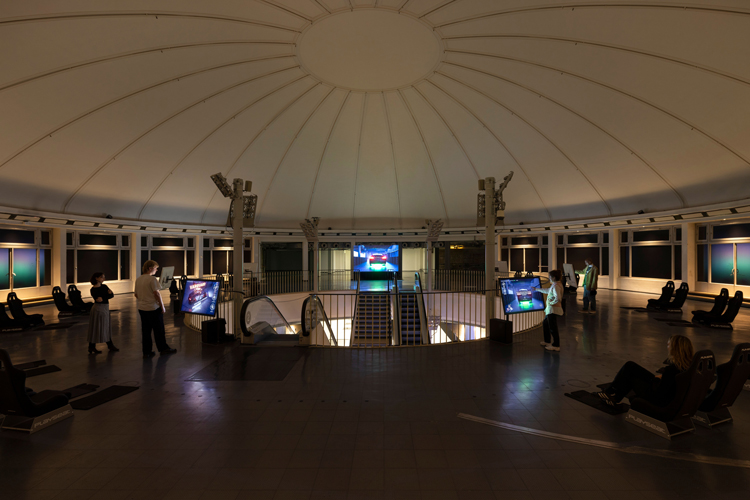
Lawrence Lek, NOX, 2023. Installation view, LAS Art Foundation, Kranzler Eck, Berlin. © Lawrence Lek. Commissioned by LAS Art Foundation. Photo: Andrea Rossetti.
On the top floor, interactive gaming screens broaden the already sophisticated world building. Here you can pay tokens to heal or train the autonomous car, even teaching it how to avoid road obstacles for safer driving. The game is basic, but well put together, extending the question: if the viewer is put in the position of developer and teacher, can it change our relationship to this hyper intelligence? Really, though, this is a work that explores the limits of human empathy through the vulnerability of an AI system. In the dark, vacuous floors of the Kranzler Eck, it feels far too abstract a question to really judge.